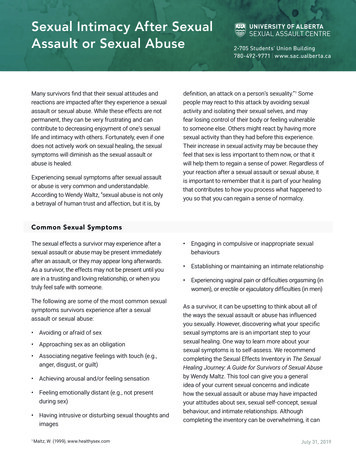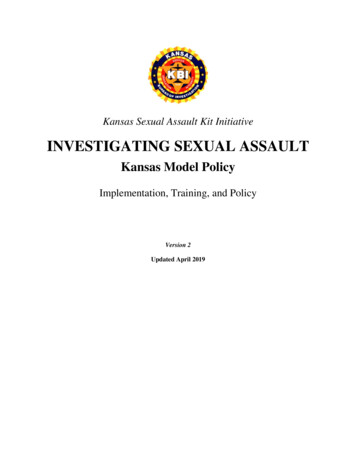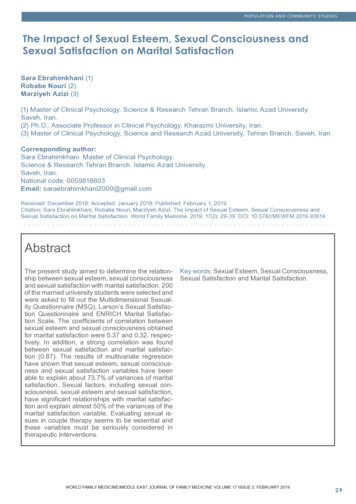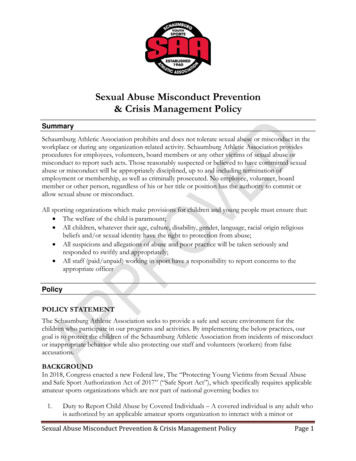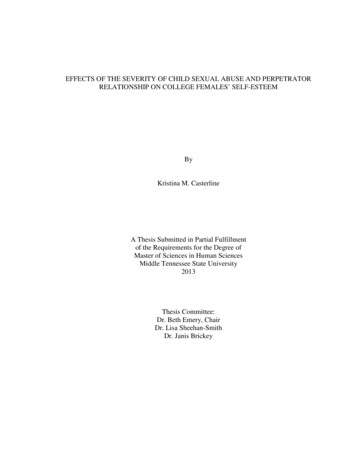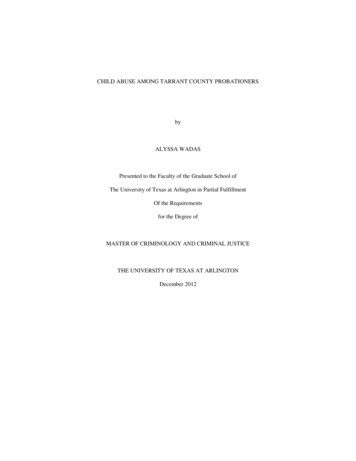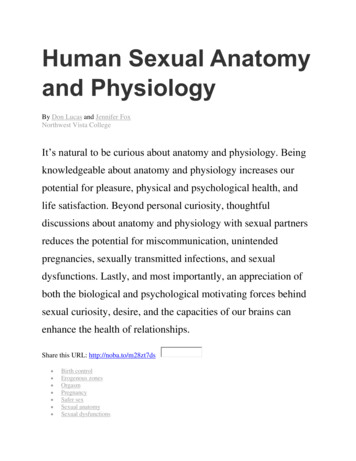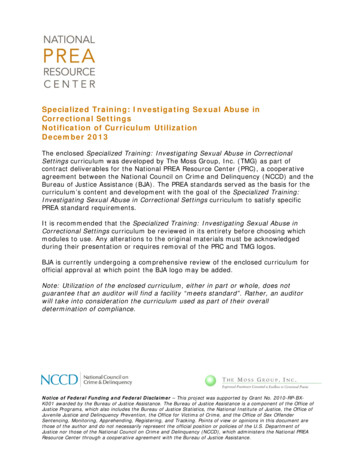
Transcription
Specialized Training: Investigating Sexual Abuse inCorrectional SettingsNotification of Curriculum UtilizationDecember 2013The enclosed Specialized Training: Investigating Sexual Abuse in CorrectionalSettings curriculum was developed by The Moss Group, Inc. (TMG) as part ofcontract deliverables for the National PREA Resource Center (PRC), a cooperativeagreement between the National Council on Crime and Delinquency (NCCD) and theBureau of Justice Assistance (BJA). The PREA standards served as the basis for thecurriculum’s content and development with the goal of the Specialized Training:Investigating Sexual Abuse in Correctional Settings curriculum to satisfy specificPREA standard requirements.It is recommended that the Specialized Training: Investigating Sexual Abuse inCorrectional Settings curriculum be reviewed in its entirety before choosing whichmodules to use. Any alterations to the original materials must be acknowledgedduring their presentation or requires removal of the PRC and TMG logos.BJA is currently undergoing a comprehensive review of the enclosed curriculum forofficial approval at which point the BJA logo may be added.Note: Utilization of the enclosed curriculum, either in part or whole, does notguarantee that an auditor will find a facility “meets standard”. Rather, an auditorwill take into consideration the curriculum used as part of their overalldetermination of compliance.Notice of Federal Funding and Federal Disclaimer – This project was supported by Grant No. 2010-RP-BX K001 awarded by the Bureau of Justice Assistance. The Bureau of Justice Assistance is a component of the Office ofJustice Programs, which also includes the Bureau of Justice Statistics, the National Institute of Justice, the Office ofJuvenile Justice and Delinquency Prevention, the Office for Victims of Crime, and the Office of Sex OffenderSentencing, Monitoring, Apprehending, Registering, and Tracking. Points of view or opinions in this document arethose of the author and do not necessarily represent the official position or policies of the U.S. Department ofJustice nor those of the National Council on Crime and Delinquency (NCCD), which administers the National PREAResource Center through a cooperative agreement with the Bureau of Justice Assistance.
Module 7:Interviewing Victims of Sexual AbuseNotice of Federal Funding Disclaimer – This project was supported by Grant No. 2010-RP-BX-K001 awarded by the Bureau of JusticeAssistance. The Bureau of Justice Assistance is a component of the Office of Justice Programs, which also includes the Bureau of Justice Statistics,the National Institute of Justice, the Office of Juvenile Justice and Delinquency Prevention, the Office for Victims of Crime, and the Office of SexOffender Sentencing, Monitoring, Apprehending, Registering, and Tracking. Points of view or opinions in this document are those of the author anddo not necessarily represent the official position or policies of the U.S. Department of Justice nor those of the National Council on Crime andDelinquency (NCCD), which administers the National PREA Resource Center through a cooperative agreement with the Bureau of JusticeAssistance.
Module 7: dgatingorreints ofnoitaginvesti buse inaexualsntesettings.meniconf
Sound Foundation In order to conduct a solid, respectful andproductive interview you must believe in theimportance of the job. You must fully understand the profiles of theindividuals you are interviewing. You must be comfortable with discussingdetailed, graphic, sexual situations even if itdoes not match your beliefs and values.
A Question of the AudiencePrivate Encounter
What do you think about sex? ViewsUpbringing BeliefSystem PersonalValues Culture LifestyleExposureAutomatic
InterviewThe first responders only do aninitial, informational interview.The formal interview will beconducted by the staff assignedto the investigation who havebeen trained to do so.
What is a Victim Interview?A controlled conversation where questions areasked of a willing and cooperative victim orwitness Why: to illicit information in an effort to getanswers to questions regarding a crime How: by asking open-ended and non-judgmentalquestions
Video and Activity
Interviewing
PreparationLogistical PreparationPREA standard 115.21 requires that a victim of sexual abuse be offeredthe accompaniment of a victim advocate during the forensic medicalexam and interviews. If the victim requests it, you should allow the advocate to bepresent during interviews. However, the advocate may only provide emotional support. The advocate may not: advise the victim, coach the victim, or provide answers for the victim unless you ask the advocatea direct question.
Vulnerable Offenders May Be Developmentally Disabled Juveniles/Youngor Delayed Elderly Physically Impaired Limited Language Ability Hearing Impaired Isolated Mentally Ill New to the system Lesbian, Gay, Bisexual, Untreated AddictsTransgendered or Intersex Uneducated Previously Victimized
Interviewing
Interviewing TipsBe prepared Take a moment to set up a rapport with theinterviewee Be aware of the spectrum of victim responsesin sexual abuse cases Remain neutral and unbiased
Interviewing TipsDo I need an interpreter? In-person vs. phone Preparing the interpreter Never use inmates or facility staff If using an interpreter, be aware that it maytake time for the offender to trust and feelokay about the interpreter’s presence
Interviewing TipsActive Listening: How to? Face the speaker and make eye contact Listen to what they are saying; do not interrupt While listening, occasionally nod or say “yes” or “I see” toacknowledge that you are listening. When the speaker has finished talking, repeat back whatyou heard or observed. I hear that you are fearful. What is it that makes yourafraid? I see that you are angry at Officer Smith.
Interviewing TipsIdentify ways to cross reference and verify What if they have been a “pair” in thepast?Try to be empathetic to your victim Do not patronize or sympathize
Interviewing TechniquesBe prepared Review all the available information regardingthe case Identify all areas in which you want to try toget answers Identify areas of common ground beforequestioning Set aside an unlimited amount of time
Interviewing Techniques Learn about the victim (past victimization/trauma,personality, etc.) Learn about the suspect (any conflicts of interest, ifyou resemble the suspect in age/ race/ size/mannerisms.) Be aware of your body language (avoid distractingbehaviors, do not interrupt, stay calm.) Be aware of interviewee’s body language.
Video
Interview What do I want to know before Iinterview? “Tell me what happened”
Interviewing Techniques SettingSetting Conduct the interview away from others in aneutral and safe environment Least amount of distractions DO NOT put a “barrier” between you and theinterviewee Interview victim during a shift when suspect isnot on duty (when applicable) Explain purpose of interview
Interviewing TechniquesStart with broad and open approach Start with a broad topic and be open to anydirections the interview may go. Give your victim, witness and suspects theopportunity to talk a lot. Women are generally more verbal than menand more able to describe details andemotions.
Interview Techniques Bring the conversation to a pin point like amicroscope. Narrow the conversation with guidedquestions that focus on previous answers. Do not use closed-ended or leadingquestions.
Interviewing
Gender and CommunicationFemales may Need extra time in conversation to establishtrust and safety due to abuse history Want– an opportunity to talk and tell their story– to be heard and shown empathy Prefer concise responses and direction Be concerned about fairness and inclusivity forothers
Gender and CommunicationFemales Consider “relational language” vs. “ruleslanguage.” Relational language: Builds on strengths andrelationships– Use of “I” phrases, “I need for you to helpme understand why you aren’t taking yourmeds”– Will help you get to the real issue
Gender and CommunicationMales may Use fewer words Talk more one-to-one vs. in groups Communicate most comfortably through “parallelplay” (side by side.) Not verbally express feelings as openly. Be more likely to walk away grumbling. Be dissociated, inattentive and angry. Act out physically instead of talking.
Interviewing: LGBTI Inmates LesbianWomen or girls emotionally, physically andromantically attracted to other women or girls. GayMen or boys emotionally, physically andromantically attracted to other men or boys; canalso be used as blanket term for both gay menand lesbians. BisexualA person who is emotionally, physically andromantically attracted to both men and women orpeople regardless of their gender.
Interviewing: LGBTI Inmates TransgenderSomeone whose gender identity differs fromtheir birth sex. Gender nonconformingHaving or being perceived to have gendercharacteristics and/or behaviors that do not fitwith traditional or societal expectations. IntersexPeople who naturally develop primary orsecondary sex characteristics that areinconsistent with society’s definition of male orfemale.
Lesbian, Gay, Bisexual InmatesInmates with a sexual orientation other thanheterosexual reported significantly higher rates ofinmate-on-inmate sexual victimization and staffsexual misconduct 10 times more likely to report sexual abuse byother inmates in prison 2.5 times more likely to report sexual abuse bystaff in prison 7 times more likely to report sexual abuse byother inmates in jail 2.5 times more likely report abuse by staff in jailBeck, Allen Ph.D. et al. Sexual Victimization in Prisons and Jails Reported by Inmates, 2011-12. Washington, DC: U.S. Department of Justice, Bureau of Justice Statistics.http://www.bjs.gov/index.cfm?ty pbdetail&iid 4654
Transgender Inmates Transgender inmates may face:– Alienation from other inmates– Alienation from staff Transgender inmates may have physicalcharacteristics of the opposite sex Law suits of note brought forth by transgenderinmates– Farmer v. Brennan
Lesbian, Gay, Bisexual, Transgenderand Intersex Inmates Use the identifiers stated by the intervieweeindicates. Gender identity is a persons’ sense oftheir own gender, which is communicated toother’s by their gender expression. Use gender neutral language. (e.g. say “partner”instead of girlfriend or wife or boyfriend orhusband)
Video
Profile: Developmentally DisabledDevelopmental Disability is a sever, chronic disability that:1. Is attributable to mental or physical impairment(s)2. Manifested before age of 223. Likely to continue indefinitely4. Results in substantial functional limitations in three ormore of the following:1. Self-care2. Receptive and expressive language3. Learning4. Mobility5. Self-direction6. Capacity for independent living7. Economic self-sufficiency5. Reflects need for combination and sequence of services,supports or other assistance
Profile: Developmentally DisabledInterviewer should. Allow person to use their own words Not ask leading questions Use concrete ideas (who, what, when, where, how) Use simple vocabulary
Limited Language Ability Use vocabulary and sentences that are at theindividual’s level of cognitive and languagedevelopment Ask one question at a time; avoid lengthy complex,multiple-part questions Speak slowly and allow sufficient wait time If using an interpreter, be aware that it may taketime for the inmate to trust and feel okay about theinterpreter’s presence
Mentally Ill Obtain information about the victim’s mental healthdiagnosis so you are prepared to respondappropriately Make sure the interviewee feels safe Be prepared to let him/her walk/pace during theinterview Offer breaks; keep the interview short Consider the time of the interview in terms of thevictim’s medications Consider allowing a mental health staff to assist
Mentally Ill Inconsistencies in story may not lying Do not underestimate the interviewee Takes time - multiple interviews may benecessary
What is an Interrogation? Formal, planned questioning of a suspect,uncooperative witness or possibly a victim whobecomes uncooperative or untruthful Why: to gather and verify information given bycooperative people and the physical evidence at hand How: by asking open-ended questions with the abilityto move quickly with the flow of information, “drillingdown” to the core information
ActivityInterrogating
Techniques for Interviewing YourSuspectSetting Away from others, in a neutral environment, asmall interrogation room is best Least amount of distractions DO NOT put a barrier between you and theinterviewee Explain purpose of interview Know your case inside and out
Techniques for Interviewing YourSuspect Be aware of the need to read Miranda as you arein a custodial setting with the inmates andpossibly the corrections staff “Good Cop/Bad Cop” can work well but needsboth people to be involved and aware of the case.
Techniques for Interviewing YourSuspect Look for changes in the suspect’s story Develop a line of questions that encourageschange Articulate that changes can look untruthful and itis important to look truthful Don’t be afraid to ask emotionally chargedquestions
Techniques for Interviewing YourSuspect Look for and introduce themes, motives,intent. Ask the questions that can cause discomfort. Lock them into a story with details. There are two sides to every story and Iwould like to hear your side. Allow them to think they are in control.
Techniques for InterviewingYour Suspect Do not strive for a confession - solve the crimeby identifying truth and lies, and gatheringcircumstantial evidence Run their story backwards and forwards, start inthe middle Do not outwardly pass judgment– You do not have to “get it” to get it
Past Complaints - Same Staff Do you have access to past claims made againsta staff person? What was the end result? Do any of the claims have a similar “MO?” Do the alleged victims have anything in common(location, housing unit, body style, age, haircolor/style, vulnerability, past victimization)?
Past Complaints - Same Staff What do co-workers say? Are there any phone calls from the inmates to thestaff? Can you covertly monitor the staff person’sbehavior for an elongated amount of time?– Example: Kitchen worker, covert camera
Credibility AssessmentAfter the interview Was the information internally consistent? Was the information logical? Specific? Was the information externally consistent - did thechronology of events deviate significantly fromothers? Is there any motivation for the individual to lie obvious relationships or alliances? Is there corroborating or contradicting evidence?
Covert Operations What are your parameters? What are your state guidelines for one party andtwo party recordings? Are your facilities posted with reminder signs?
Covert Operations Are you skilled enough to set up a covertcamera? Do you know people that are? Are staff often your worst enemy?
Covert Operations What steps do you need to take to performcovert steps outside of the facility? What type of relationship do you have with yourlocal law enforcement agency?– The Post Office staff?
Systemic Issues You may not be able to prove sexual abuse butare there other issues to deal with? Identify any policy violations; such as overfamiliarization Identify what caused the violation
Systemic Issues If there are other policy or training issuesidentified, add them to an addendum report Mention the addendum in the main report Or mention the systemic issues at the end of theabuse allegation report (If not, it may get lost inthe mix)
Practice. Practice Practice.
Questions?
Specialized Training: Investigating Sexual Abuse in Correctional Settings Notification of Curriculum Utilization December 2013 The enclosed Specialized Training: Investigating Sexual Abuse in Correctional Settings curriculum was developed by The Moss Group, Inc. (TMG) as part of contract deliverables for the National PREA Resource Center (PRC), a cooperative
